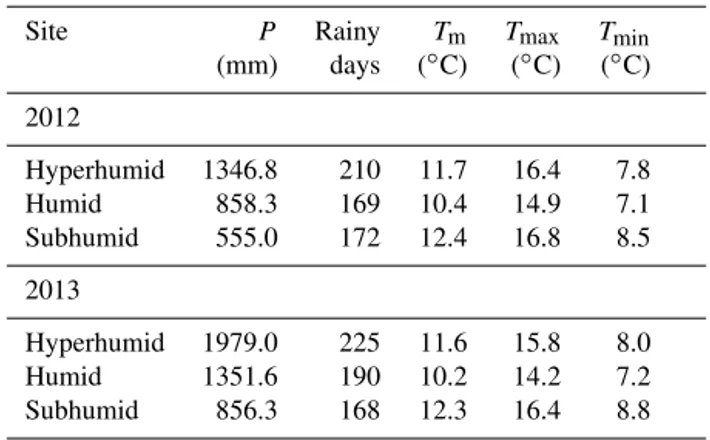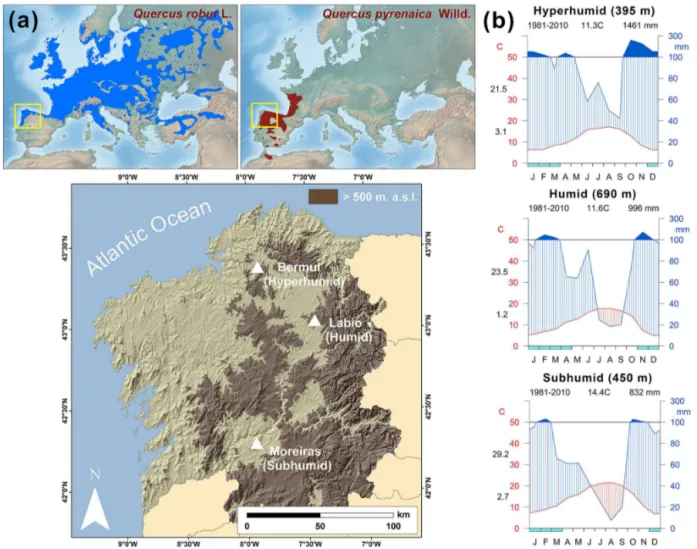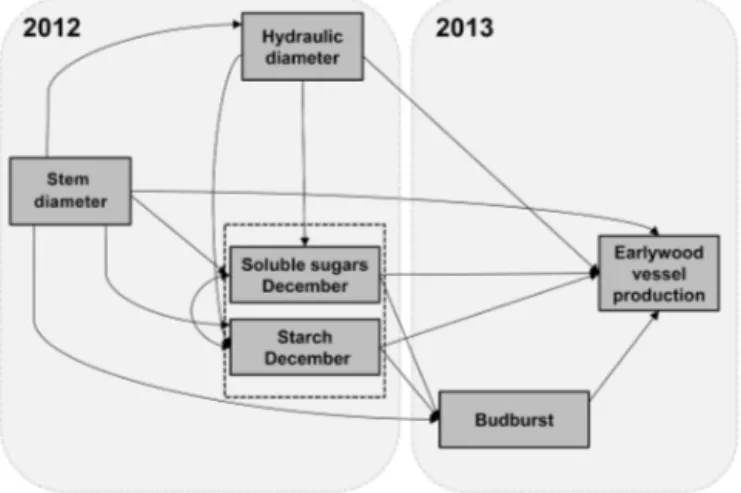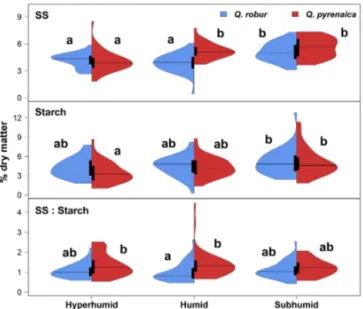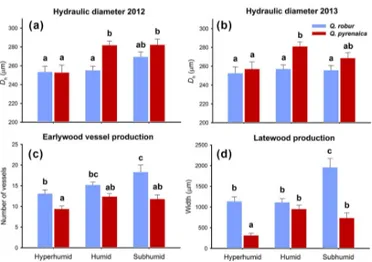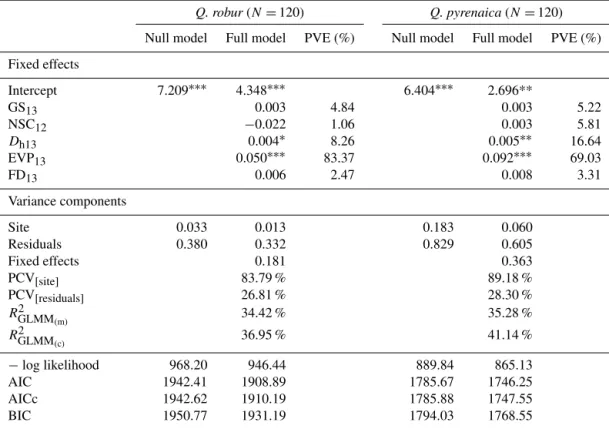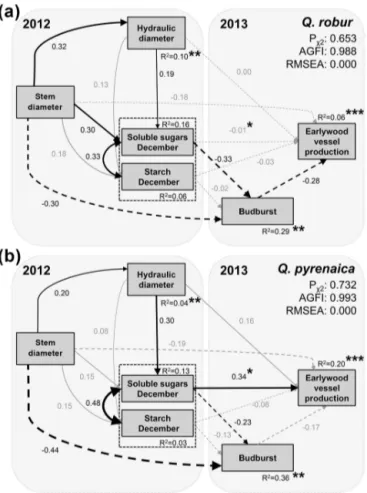www.biogeosciences.net/13/5499/2016/ doi:10.5194/bg-13-5499-2016
© Author(s) 2016. CC Attribution 3.0 License.
Feedbacks between earlywood anatomy and non-structural
carbohydrates affect spring phenology and wood
production in ring-porous oaks
Gonzalo Pérez-de-Lis1, Ignacio García-González1, Vicente Rozas2, and José Miguel Olano2 1Departamento de Botánica, Universidade de Santiago de Compostela, EPS, 27002 Lugo, Spain 2Área de Botánica, EUI Agrarias, Universidad de Valladolid, 42004 Soria, Spain
Correspondence to:Gonzalo Pérez-de-Lis (gonzalo.perezdelis@usc.es)
Received: 25 May 2016 – Published in Biogeosciences Discuss.: 26 May 2016
Revised: 7 September 2016 – Accepted: 16 September 2016 – Published: 5 October 2016
Abstract.Non-structural carbohydrates (NSC) play a central role in the construction and maintenance of a tree’s vascu-lar system, but feedbacks between the NSC status of trees and wood formation are not fully understood. We aimed to evaluate multiple dependencies among wood anatomy, win-ter NSC, and phenology for coexisting temperate ( Quer-cus robur) and sub-Mediterranean (Q. pyrenaica) oaks along
a water-availability gradient in the NW Iberian Peninsula. Sapwood NSC concentrations were quantified at three sites in December 2012 (N=240). Leaf phenology and wood
anatomy were surveyed in 2013. Structural equation mod-elling was used to analyse the interplay among hydraulic di-ameter (Dh), winter NSC, budburst date, and earlywood ves-sel production (EVP), while the effect of Dh and EVP on latewood width was assessed by using a mixed-effects model. NSC and wood production increased under drier conditions for both species.Q. roburshowed a narrowerDhand lower soluble sugar (SS) concentration (3.88–5.08 % dry matter) thanQ. pyrenaica(4.06–5.57 % dry matter), butQ. robur
ex-hibited larger EVP and wider latewood (1403 µm) than Q. pyrenaica (667 µm). Stem diameter andDh had a positive effect on SS concentrations, which were related to an ear-lier leaf flushing in both species. Sapwood sugar content ap-peared to limit EVP exclusively inQ. pyrenaica. In turn,Dh and EVP were found to be key predictors of latewood growth. Our results confirm that sapwood SS concentrations are in-volved in modulating growth resumption and xylem produc-tion in spring.Q. pyrenaicaexhibited a tighter control of
car-bohydrate allocation to wood formation thanQ. robur, which
would play a role in protecting against environmental stress in the sub-Mediterranean area.
1 Introduction
are therefore needed to provide energy and materials for leaf expansion and cambial activity at the onset of the growing season (El Zein et al., 2011).
Large vessels are presumed to boost carbon gain because stomatal conductance increases with the hydraulic capacity (Fichot et al., 2009). Concurrently, more carbohydrates may be allotted to hydraulic purposes in trees with wider but more vulnerable vessels (Salleo et al., 2009; Brodersen and McEl-rone, 2013). However, little is known about feedbacks be-tween wood anatomy and short-distance NSC mobilization, which are probably influenced by tree vigour. Large, domi-nant trees commonly exhibit higher NSC levels and a faster NSC turnover (Sala and Hoch, 2009; Carbone et al., 2013; DeSoto et al., 2016), as well as wider vessels at the tree base to compensate for height-related hydraulic resistance in the stem (Petit et al., 2008). In turn, entangled relationships be-tween tree vigour and growth are influenced by the timing of tree phenology, given that dominant trees show larger grow-ing periods and more intense cambial activity (Rathgeber et al., 2011). Although the break in dormancy is mostly con-trolled by temperature and photoperiod (Basler and Körner, 2014), some studies suggest that high NSC concentrations in developing buds speed up leaf-out dates (Maurel et al., 2004). In winter, phloem of deciduous trees is probably non-functional, whereby sapwood might be involved in carbon translocation through the plant (Lacointe et al., 2004). The influx of sucrose from xylem conduits in branches into the buds was reported to be tightly correlated to bud swelling rates (Bonhomme et al., 2010), whilst high sucrose concen-trations in the stem of mutant poplars have been associated with an advanced budburst (Park et al., 2009). Cascade ef-fects of leaf phenology on secondary growth would conse-quently be expected, given that leaf and cambial phenology are coordinated at the whole-tree level (Pérez-de-Lis et al., 2016). In ring-porous oaks, winter temperature has been re-ported to affect earlywood formation, which has been at-tributed to thermally induced changes in respiratory demands and NSC levels (Gea-Izquierdo et al., 2012). However, the in-terplay between NSC, phenology, and tree growth is poorly understood.
Ecological requirements modulating phenology are linked to functional species-specific strategies (Basler and Körner, 2014). This is the case of the ring-porous oaksQuercus robur
L. andQ. pyrenaicaWilld., which coexist in the NW Iberian
Peninsula. The former is widespread in Europe, being abun-dant in areas with mild-oceanic climate. By contrast,Q. pyre-naica is dominant in various mountain ranges of the
sub-Mediterranean area, hence exhibiting multiple adaptations to cope with summer drought and winter frost, such as late flushing (Pérez-de-Lis et al., 2016). These differences could impact carbon metabolism and allocation to growth (Val-ladares et al., 2000; Piper, 2011; Guillemot et al., 2015), as well as the rate of developmental processes (Deslauriers et al., 2009), affecting the adaptive capacity to track rapid cli-mate change (Jump and Peñuelas, 2005). Water shortage is
Table 1.Climatic information on the study sites in 2012 and 2013.
Site P Rainy Tm Tmax Tmin
(mm) days (◦C) (◦C) (◦C)
2012
Hyperhumid 1346.8 210 11.7 16.4 7.8
Humid 858.3 169 10.4 14.9 7.1
Subhumid 555.0 172 12.4 16.8 8.5
2013
Hyperhumid 1979.0 225 11.6 15.8 8.0
Humid 1351.6 190 10.2 14.2 7.2
Subhumid 856.3 168 12.3 16.4 8.8
P, mean precipitation;Tm, mean temperature;Tmax, mean maximum temperature;Tmin, mean minimum temperature.
deemed to influence carbon metabolism in a complex manner by constraining the activity of both source and sink organs (Sala et al., 2012), and by changing sugar fractions (Deslau-riers et al., 2014). While some studies have suggested that declining growth demand under drought causes NSC to be accumulated (Sala and Hoch, 2009; Lempereur et al., 2015; DeSoto et al., 2016), other authors have found a reduction in starch concentration under long-term drought (Rosas et al., 2013). Therefore, we need to understand how phenology and growth are coordinated with NSC in order to better predict plant responses to climate in the context of global warming.
In this research, data from stem sapwood NSC concentra-tion in winter 2012, xylem anatomical traits, and leaf phe-nology in spring 2013 (as a proxy for cambial phephe-nology) are used to disentangle the influence of their mutual interac-tions on the radial growth of ring-porous oaks growing along a water-availability gradient in the NW Iberian Peninsula. We focus on the possible differences in xylem anatomy and NSC levels betweenQ. roburandQ. pyrenaicaalong the
gradi-ent. In this regard, wood production and stem sapwood NSC concentration are expected to vary along the gradient, with reduced growth but increasing NSC storage under drier con-ditions. We also hypothesize that the more drought-tolerant
Q. pyrenaicawill have xylem growth that is more reduced
thanQ. roburbut larger stem sapwood NSC concentrations.
Figure 1. (a)Location of the study sites in the NW Iberian Peninsula and distribution range ofQuercus roburandQ. pyrenaica(base map: http://www.euforgen.org).(b)Climatic diagrams of the sites including site altitude in m a.s.l, mean annual temperature, and total annual precipitation for the specified period.
2 Materials and methods
2.1 Study sites
The study area is located in the NW Iberian Peninsula, at the transition between the Atlantic and Mediterranean bio-geographical regions (Fig. 1a). The experiment was con-ducted at three mixed stands of Q. robur (hereafter Qrob)
andQ. pyrenaica(hereafterQpyr) located along a
north-to-south transect of 120 km, following a gradient of decreas-ing water supply (Fig. 1b). Annual rainfall declines from 1461 mm at the northernmost site Bermui (hyperhumid), to 996 mm at Labio (humid), and to 832 mm at the southern-most site Moreiras (subhumid). Mean annual temperature is lower at the hyperhumid (11.3◦C) and humid (11.6◦C) sites than at the subhumid site (14.4◦C). Sampled stands are dominated byQrobat the hyperhumid and humid sites,
whereas Qpyr is more frequent at the subhumid location.
Forests at the hyperhumid and humid sites include temperate
trees and understorey shrubs, such asBetula albaL., Cas-tanea sativaMill.,Pyrus cordataDesy.,Ilex aquifoliumL., Daboecia cantabrica(Huds.) K. Koch, andVaccinium myr-tillusL. By contrast, thermophilic Mediterranean flora, such
asQ. suberL.,Laurus nobilisL.,Arbutus unedoL.,Osyris albaL., andDaphne gnidium L., dominates the subhumid
2.2 Phenology and NSC concentration
At each study site, 40 trees per species were randomly se-lected from those belonging to the dominant and intermedi-ate crown classes (overallN=240), while highly suppressed
and juvenile individuals were disregarded. In October 2012, we measured stem diameter from all selected individuals with a diameter tape, while tree height was estimated with a Blume-Leiss hypsometer. Leaf phenology was weekly mon-itored during 2013 using binoculars (10×) at ca. 10 m
dis-tance from the stem. For each tree, budburst was identified as the day of year (DOY) in which the apical buds on the uppermost part of the crown were green and expanding, but no leaves were distinguishable yet. We considered budburst to be an indicator for cambial resumption in the stem, ac-cording to the high correlations observed between these two events in our study sites (Pérez-de-Lis et al., 2016). In late autumn, leaf shedding was identified as the date in which at least 50 % of the leaves were shed from the crown. In ad-dition, foliage density was visually estimated in July 2013 by counting the proportion of gaps in the crown and was ex-pressed as a percentage of the theoretical maximum foliage density.
In order to analyse feedbacks between NSC and xylem anatomy, we quantified the content of NSC in sapwood by sampling one 5 mm diameter wood core per tree with an increment borer at breast height. Cores were taken in mid-December 2012, soon after the completion of leaf abscission, which occurred between mid- and late November for both species. After extraction, cores were immediately placed into a cool box, and subsequently stored at −20◦C to prevent
carbohydrate degradation. Before NSC extraction, we iden-tified the boundary between sapwood (pale-coloured) and heartwood (brown-coloured). Bark and traces of heartwood were removed, and the cores were oven-dried at 60◦C for 72 h. Sapwood was then finely grounded with a mixer mill (Retsch MM 400, Düsseldorf, Germany). We quantified NSC concentration for the whole sapwood by using the anthrone method (Olano et al., 2006). SS were extracted from 20 mg of dry mass in 1 mL of ethanol (80 %) at 80◦C for 30 min. The extract was centrifuged for 10 min at 4000 rpm, and the supernatant was collected for the spectrophotometrical de-termination of SS concentrations, for which we used the an-throne reagent. Starch contained in the residue was hydrol-ysed with 1 mL of perchloric acid (35 %) for 1 h, and deter-mination was conducted by using the anthrone reagent, as previously described for SS. Total NSC, SS, and starch con-centrations were expressed as a percentage of dry matter.
2.3 Wood anatomical measurements
In October 2013, one additional core was collected from all the selected trees to perform wood anatomical mea-surements. Cores were air-dried and mounted on wooden supports to be cut using a microtome (WSL Core
Micro-Figure 2.Structure of the hypothetical conceptual model showing interactions among stem diameter, hydraulic diameter in 2012, sol-uble sugars and starch concentrations in December 2012, and bud-burst date and earlywood vessel production in 2013.
tome, Zurich, CH) and polished. Cross-sectional surfaces were photographed with a digital camera (Canon EOS 600D, Tokyo, Japan) attached to a transmitted light microscope (Olympus BX40, Tokyo, Japan). Image analysis was applied on the rings formed in 2012 and 2013 using ImageJ 1.48v (Schneider et al., 2012) in order to quantify the lumen area of earlywood vessels, latewood width, and the number of early-wood vessels, which is a proxy of earlyearly-wood vessel produc-tion (EVP). For each vessel, we estimated the diameter of the equivalent circle, obtaining the hydraulic diameter (Dh) at the tree level according to the following equation:
Dh= N
P
n=1 dn5
N
P
n=1 dn4
, (1)
wherednis the diameter of thenvessel (Sperry et al., 1994). According to the Hagen–Poiseuille equation,Dh is propor-tional to the hydraulic capacity.
2.4 Comparisons along the gradient
2.5 Connections among earlywood anatomy, sapwood NSC content, and spring phenology
We performed structural equation models (SEMs) to disen-tangle the role of winter NSC content as a possible regulator of budburst and EVP in 2013 at the species level. Thereby, data from all sites were pooled, and a unique model was fitted for each species. An SEM approach provides an ade-quate representation for interacting systems, in which simul-taneous influences and responses, including direct and indi-rect effects, are explored (Grace, 2006). The structure of a hypothetical SEM, and its calculation, requires incorporat-ing available a priori knowledge. Accordincorporat-ing to the lines of evidence showed in the introduction, we hypothesized that larger trees show higher SS and starch concentrations due to their largerDh(Fig. 2). In turn, high SS and starch concen-trations in winter are expected to speed up tree phenology (budburst date) and boost EVP during the following year.
Standardized coefficients were estimated by the maximum likelihood method, and model evaluation was performed us-ing aχ2 test. AP value below 0.05 indicates that discrep-ancy between observed and expected covariance matrices is acceptable. The adjusted goodness of model fit index (AGFI) and the root mean square error of approximation (RMSEA) were complementarily performed in order to consider the ef-fect of sample size on the model fit evaluation. Values of AGFI above 0.90 and RMSEA below 0.05 indicate an ac-ceptable fit of the model in relation to the degrees of freedom. Aχ2test for multi-group invariance was applied to evaluate differences between the models fitted for each species. SEM analyses were carried out with AMOS 18.0 software (AMOS Development Corp., Mount Pleasant, South Carolina, USA).
2.6 Predictors of latewood formation
We performed generalized linear mixed-effects models (GLMMs) to identify how earlywood anatomy, foliage den-sity, phenology, and winter NSC levels affected latewood production in 2013. The effect of site was included as a ran-dom component, while winter NSC, earlywood anatomy (Dh and EVP in 2013), growing season length, and foliage den-sity were the explanatory variables of the model. Collinear-ity was surveyed by calculating the generalized variance-inflation factors for each species. GLMMs were fitted by a log-link function with a gamma distribution, being ranked according to the corrected Akaike’s information criterion (AICc; Bolker et al., 2009). We averaged the 95 % confi-dence set of models according to the Akaike’s weights, and the relative importance of a given variable was calculated as the sum of the weights across all models in which it was contained (Burnham and Anderson, 2002). Marginal (fixed effects only) and conditionalR2(both fixed and random ef-fects) were calculated by using the variance components of fixed and random factors and the residuals. The proportion change in variance (PCV) was quantified to provide the
vari-Figure 3.Distribution of soluble sugars (SS), starch concentrations, and SS-to-starch ratio, forQuercus robur(N=120) andQ. pyre-naica(N=120) at the three study sites. Horizontal lines represent
the median, and black box plots show the extent of 25th and 75th percentiles. Lower-case letters indicate statistically significant dif-ferences along the gradient according to multiple pairwise compar-isons. Note that different scales are used on theyaxis for each set of distributions.
ability in latewood width explained by the full model (con-taining fixed and random effects), as compared to the null model (only containing the random component). Comple-mentarily, we estimated the percentage of the variance ex-plained by each fixed factor, and both full and null models were ranked according to the minimum AICc and Bayesian information criterion (BIC) scores. Variance partitioning, R2and PCV calculations were performed by following the methods reported by Nakagawa and Schielzeth (2013). We used the packages “lme4” and “MuMIn” for R 3.1.1 (R Core Team, 2014) to assess GLMM estimates, variance partition-ing, and statistics.
3 Results
3.1 Variation in NSC, wood anatomy, and leaf phenology along the gradient
Mean SS concentrations along the gradient ranged from 3.88 to 5.08 % dry matter inQroband from 4.06 to 5.57 % dry
matter inQpyr, being similar to those of starch, which ranged
from 4.28 to 5.11 % dry matter inQrob and from 3.47 to
5.11 % inQpyr(Fig. 3). As a result,Qpyrexhibited greater
espe-Figure 4.Mean values and SE of(a)hydraulic diameter in 2012,
(b) hydraulic diameter in 2013,(c)earlywood vessel production, and(d)latewood production in 2013 forQuercus robur(N=120)
and Q. pyrenaica (N=120). Lower-case letters indicate
statisti-cally significant differences along the gradient according to multiple pairwise comparisons.
cially at the humid location (Fig. 3), although there was no variation along the gradient (F =0.21,P =0.814). In
con-trast, SS content decreased in both species from the sub-humid to the hypersub-humid site (Qrob F[2,117]=17.72,Qpyr F[2,117]=21.89,P < 0.001). The subhumid site exhibited a higher starch content than the hyperhumid location forQpyr
(F[2,117]=8.59, P< 0.001), whereas no clear pattern was found forQrob(F[2,117]=2.52,P =0.085).
Overall, Qpyr exhibited a higher Dh than Qrob (2012
F[1,236]=7.76, 2013 F[1,236]=8.31, P< 0.010; Fig. 4a). The highest Dh values were found for Qpyr at the
hu-mid (both years) and subhuhu-mid sites (2012), while Qrob
had a more reduced variation along the gradient (2012 F[2,117]=2.89, 2013 F[2,117]=0.18, P> 0.050; Fig. 4b). EVP and latewood width were higher inQrobthan inQpyr
at the hyperhumid and subhumid sites, whereas differences were non-significant at the humid location (Fig. 4c, d). Trees at the subhumid site exhibited wider latewood (both species) and higher EVP (Qrob) than those at the hyperhumid
loca-tion (Fig. 4c, d).
Qrobhad a larger stem diameter thanQpyrat the
hyper-humid site, whereas similar values were found at the hu-mid and subhuhu-mid locations (Fig. 5a). Stem diameter was positively correlated with tree height inQrob(r[118]=0.60, P < 0.001) andQpyr(r[118]=0.58,P< 0.001). Trees of both species were taller at the hyperhumid and subhumid sites than at the humid location (Qrob F[2,117]=22.85, Qpyr F[2,117]=29.46,P< 0.001).Qrobexhibited an earlier bud-burst than Qpyr (F[1,236]=527.83, P< 0.001), occurring from early March to late April for the former and from mid-April to late May for the latter. In both species, budburst oc-curred earlier at the subhumid site than at humid and
hyper-Figure 5.Mean values and SE of(a)stem diameter,(b)budburst date,(c)date of leaf shedding, and(d)foliage density in 2013 for
Quercus robur(N=120) andQ. pyrenaica(N=120). Lower-case
letters indicate statistically significant differences along the gradient according to multiple pairwise comparisons.
humid locations (Fig. 5b). By contrast, leaf shedding was first recorded at the hyperhumid and humid sites forQpyr(DOY
312 on average; Fig. 5c), whereas some green leaves could be perceived until late December at the subhumid site (Qrob
DOY 357,QpyrDOY 354). The leaf period was on average
42 days longer forQrobthan for Qpyr(F[1,236]=450.90, P< 0.001) in 2013. Foliage density was similar along the gradient forQrob, but significantly lower at the hyperhumid
site forQpyr(Fig. 5d). It is also relevant that numerousQpyr
trees at the hyperhumid site had their leaves infected with powdery mildew in spring 2013.
3.2 Species-specific models on functional relationships affecting wood production
SEMs showed a good fit for both species (Qrob,
χ[12,N=120]=0.202, P =0.653; Qpyr, χ[12,N=120]=0.118, P =0.732), with AGFI > 0.90 and RMSEA < 0.1 (Fig. 6a,
b). Stem diameter had a positive indirect effect on SS lev-els that was mediated byDh in 2012. Large trees exhibited an earlier budburst date, partially related to their higher SS concentrations in winter. InQrob, SS content affected EVP
by mediating budburst date, although our model explained a low amount of the observed variability in EVP (Fig. 6a). In
Qpyr, SS concentrations had a positive direct effect on EVP,
with an acceptableR2 value for EVP (R2=0.20; Fig. 6b).
Neither EVP nor budburst date responded to winter starch concentration, although our model failed to account for the observed variability in the latter variable.
Table 2.Statistics of the null and full generalized linear models forQuercus robur(left) andQ.pyrenaica(right).
Q. robur(N=120) Q. pyrenaica(N=120)
Null model Full model PVE (%) Null model Full model PVE (%)
Fixed effects
Intercept 7.209∗∗∗ 4.348∗∗∗ 6.404∗∗∗ 2.696**
GS13 0.003 4.84 0.003 5.22
NSC12 −0.022 1.06 0.003 5.81
Dh13 0.004∗ 8.26 0.005∗∗ 16.64
EVP13 0.050∗∗∗ 83.37 0.092∗∗∗ 69.03
FD13 0.006 2.47 0.008 3.31
Variance components
Site 0.033 0.013 0.183 0.060
Residuals 0.380 0.332 0.829 0.605
Fixed effects 0.181 0.363
PCV[site] 83.79 % 89.18 %
PCV[residuals] 26.81 % 28.30 %
RGLMM2
(m) 34.42 % 35.28 %
RGLMM2
(c) 36.95 % 41.14 %
−log likelihood 968.20 946.44 889.84 865.13
AIC 1942.41 1908.89 1785.67 1746.25
AICc 1942.62 1910.19 1785.88 1747.55
BIC 1950.77 1931.19 1794.03 1768.55
N, sample size for each species. PVE, relative proportion of variance explained by each fixed factor. GS13, length of the growing season in 2013. NSC12, total non-structural carbohydrates in December 2012.Dh13, hydraulic diameter in 2013. EVP13, earlywood vessel production in 2013. FD13, foliage density in 2013. PCV, proportion change in variance.R2GLMM
(m), marginal coefficient of determination. R2GLMM
(c), conditional coefficient of determination. AIC, Akaike’s information criterion. AICc, corrected Akaike’s information criterion.
BIC, Sawa’s Bayesian information criterion.∗∗∗P≤0.001;∗∗P≤0.01;∗P≤0.05.
model with respect to the null one. A similar result was ob-tained after ranking the models according to their AICc, log likelihood, and BIC scores (Table 2). Larger and more nu-merous earlywood vessels strongly favoured latewood pro-duction (Table 2). In fact, EVP andDhwere the most relevant predictors, attaining a relative influence above 85 % (Fig. 7). However, EVP accounted for 69 (83) % of the variability in latewood width predicted by the fixed part of the model for
Qpyr(Qrob), whereasDhonly explained 8–16 % (Table 2). Variables related to tree vigour were less relevant, such as foliage density (40–60 %) and length of the growing season (31–40 %), with no significant effects on latewood width (Ta-ble 2). Winter NSC only accounted for a marginal weight in both species, having a negative slope forQrobbut positive
forQpyr(Table 2, Fig. 7). Problems of collinearity were not
detected among the predictors included in the model (Sup-plement, Table S1).
4 Discussion
4.1 NSC allocation to xylem growth reflects contrasting stress-tolerance strategies in oaks
According to our expectations, sapwood SS content de-creased from the subhumid to the hyperhumid site for both species, and starch content followed a similar pattern for
Qpyr. More immediate effects of water shortage on stem
growth than on photosynthesis likely favoured carbohydrate accumulation in the previous summer (Sala et al., 2012; Lem-pereur et al., 2015; DeSoto et al., 2016). Such a response should be adaptive in dry environments because sugars con-tribute to prevent desiccation through osmotic regulation and cavitation repair (Salleo et al., 2009; Brodersen and McEl-rone, 2013; Pantin et al., 2013; Deslauriers et al., 2014). The fact thatQpyrshowed larger vessels at the humid and
Figure 6.Structural equation models fitted for(a)Quercus robur (N=120) and(b) Q. pyrenaica(N=120). Variables of the
con-ceptual model are stem diameter, hydraulic diameter in 2012, sol-uble sugars and starch concentrations in December 2012, budburst date, and earlywood vessel production (number of vessels) in 2013. Explained deviances of endogenous variables are shown near the boxes. Solid black (positive effects) and dashed (negative effects) arrows denote significant relations, while non-significant relations are shown as grey coefficients and arrows. The χ2 test, the ad-justed goodness of model fit index (AGFI), and the root mean square error of approximation (RMSEA) are shown for each model. Asterisks indicate paths or error values significantly different be-tween the models of both species.∗∗∗
P ≤0.001,∗∗P ≤0.01, and
∗P≤0.05.
that enhanced SS concentration might be involved in com-pensating hydraulic vulnerability in this species.
Wood formation declined along with NSC content from the subhumid toward the hyperhumid site, which contra-dicts our expectations, and also a possible trade-off between NSC accumulation and growth. A shorter growing season at the hyperhumid and humid locations could restrict pho-tosynthesis (Morecroft et al., 2003), as well as xylem for-mation (Rathgeber et al., 2011). A lower tree density at the subhumid site might be associated with a reduced inter-tree competition, which is assumed to favour both carbon uptake and xylem growth (Fernández-de-Uña et al., 2016).
Figure 7.Relative importance of the variables driving latewood
production in 2013, expressed as a percentage, forQuercus robur (N=120) andQ. pyrenaica(N=120). Site effect was included as
a random factor in the model. NSC12are total non-structural car-bohydrates in December 2012,Dh13is hydraulic diameter in 2013, EVP13 is earlywood vessel production in 2013, GS13 is length of the growing season in 2013, and FD13is foliage density in 2013. Different colours of bars denote variables with either a positive or negative effect.
Strong differences between the two Atlantic sites forQpyr,
however, contrasted with their similar tree density. Soil wa-ter excess in winwa-ter at the hyperhumid site could exacer-bate carbon consumption associated with fermentation pro-cesses and root anaerobic stress (Ferner et al., 2012). More-over,Qpyr trees exhibited sparser foliage and more severe
powdery mildew infestation at the hyperhumid site, which may reduce NSC levels and growth (Améglio et al., 2001; Martínez-Vilalta, 2014; Camarero et al., 2016). Growth de-cline and tree dieback were indeed recently reported for oaks suffering from both high competition levels and water excess after extremely rainy periods (Rozas and García-González, 2012).
The sub-Mediterranean Qpyr exhibited a higher
SS-to-starch ratio at the onset of dormancy than the temperate
Qrob, although NSC content was similar for both species.
Sugars play a key role in the osmotic protection against freez-ing damage (Améglio et al., 2004), whereby higher sym-plastic SS concentrations would reflect stronger cold toler-ance (Morin et al., 2007), as is the case for Qpyr. On the
other hand, EVP and latewood width were generally lower for Qpyr than for Qrob, particularly under more
Mediter-ranean climatic conditions. This contradictory outcome sug-gests thatQpyris more conservative than Qrobin
out-competedQpyrin our study sites, demonstrating that
temper-ate oaks are more competitive than sub-Mediterranean ones (Rodríguez-Calcerrada et al., 2008; Grossiord et al., 2014). However, validation of these hypotheses requires further re-search quantifying the whole-tree NSC pool size and the ac-tivity of complementary carbon sinks. In this regard, a recent study suggested that neighbouring Qpyrtrees were able to
share NSC through the root system, which is an important carbon reservoir within the tree (Salomon et al., 2016).
4.2 Dependencies among NSC content, phenology, and earlywood vessels
Our SEMs confirmed the hypothesized functional relation-ships among earlywood anatomy, spring phenology, and NSC content. The growing season started earlier in large trees, which is in line with previous studies analysing cam-bial activity (Rathgeber et al., 2011). Stem diameter also had a positive effect on SS content at dormancy, which was mediated by the hydraulic capacity (i.e. vessel size). En-hanced water transport capacity in trees with large vessels may boost carbohydrate uptake under a high evaporative de-mand (Meinzer et al., 2005; Fichot et al., 2009). Alterna-tively, since large vessels are thought to be more vulnera-ble to cavitation (Sperry et al., 1994), higher SS concentra-tions may be required in the sapwood of trees bearing wider vessels to maintain long-distance water transport (Brodersen and McElrone, 2013). Trees with a higher SS concentration in the stem showed earlier budburst in the following spring, as reported in poplar (Park et al., 2009). Bud swelling de-pends on sugar influx from sapwood vessels (Maurel et al., 2004; Bonhomme et al., 2010), which have been suggested to be responsible for carbohydrate transport during the dor-mant period (Lacointe et al., 2004). In addition, xylem sap osmolarity plays a role in the generation of the stem pressure needed to reverse winter embolisms in early spring (Améglio et al., 2001). A reduced ability to repair embolism in trees with low xylem sap SS concentration could thus negatively affect the supply of water to swelling buds (Améglio et al., 2001).
EVP was in tune with SS concentration forQpyr, whereas
this effect was irrelevant forQrob. Such a discrepancy in the
effect of stored carbohydrates on growth is consistent with the aforesaid carbon use strategies, and could reflect the con-trasting stress tolerance of the study species (Guillemot et al., 2015). Our results consequently suggest thatQpyrwas able
to limit construction costs in spring according to SS levels. Presumably, high overwintering SS levels in sapwood some-how increased energy and materials as well as water sup-plied to growing tissues in spring, even though starch mobi-lization may be initiated at that time (Améglio et al., 2001). Furthermore, sugars are elicitors of auxin biosynthesis and distribution (Lilley et al., 2012; Sairanen et al., 2012), as well as growth promoters (Stewart et al., 2011). Although relations between carbon accumulation and growth are
com-plex, and mainly related to the activity of carbon sinks (Lem-pereur et al., 2015), a growing body of literature suggests that NSC availability is involved in growth regulation (Pantin et al., 2013; Dietze et al., 2014; Guillemot et al., 2015). This can be particularly true for earlywood given its reliance on stored carbohydrates (Skomarkova et al., 2006). This idea agrees with the direct association between tree vigour, NSC pool, and growth found in multiple species (Deslauriers et al., 2009; Carbone et al., 2013), as well as with the observed positive effect of CO2fertilization on tree growth (Nissinen et al., 2016). EVP did not respond to sapwood starch con-tent, which suggests that thermal-induced changes in starch breakdown during cold hardening could be more decisive than the total amount of reserves. This is consistent with the connection between earlywood anatomy and autumn–winter temperature reported by dendrochronological studies (Gea-Izquierdo et al., 2012). However, the actual starch availabil-ity could be overestimated if starch contained in sapwood is partially inaccessible (Sala et al., 2012).
4.3 Earlywood anatomy is a predictor of latewood growth
The most influential predictors driving latewood growth did not differ betweenQrobandQpyr, suggesting common
5 Conclusions
In this study, non-structural carbohydrates in sapwood, wood anatomy, and leaf phenology were comprehensively ad-dressed for two ring-porous species during a 1 year period, along a broad geographical range in the NW Iberian Penin-sula. Our results reveal that feedbacks between earlywood vessels and soluble sugars involve changes in wood produc-tion. Earlywood vessel formation showed a tighter control by soluble sugar content in Q. pyrenaicathan inQ. robur,
suggesting a more conservative carbon use strategy for the former species. These lines of evidence support the idea that non-structural carbohydrates play a role in the acquisition of resistance to cope with harsh environmental conditions in the sub-Mediterranean area. We acknowledge the need for further research comprising a longer time span, solu-ble sugar fractioning, additional tree compartments such as branches and roots, and a comprehensive data set on cambial phenology instead of isolated leaf phenophases. However, this study suggests the existence of stable functional interac-tions between sapwood carbohydrate levels, xylem anatomy, and phenology in ring-porous oaks. In the light of our re-sults, we suggest that Q. pyrenaica, and to a lesser extent Q. robur, could mitigate increasing hydraulic vulnerability
under climate warming by prioritizing carbon accumulation over growth. Nevertheless, such a mechanism would impose additional limitations for secondary growth if adverse cli-mate episodes become more frequent in future decades.
6 Data availability
Data used in this article are available in the Supplement.
The Supplement related to this article is available online at doi:10.5194/bg-13-5499-2016-supplement.
Author contributions. Ignacio García-González, José Miguel Olano, and Vicente Rozas conceived and designed the experiment. Ignacio García-González, Vicente Rozas, and Gonzalo Pérez-de-Lis conducted fieldwork. Gonzalo Pérez-Pérez-de-Lis performed sample processing and data collection. José Miguel Olano and Gonzalo de-Lis executed model calculation. Gonzalo Pérez-de-Lis prepared the manuscript. Ignacio García-González, José Miguel Olano, and Vicente Rozas provided editorial advice.
Acknowledgements. The authors are grateful to G. Juste and E. Marcos for laboratory technical assistance, to A. García-Cervigón for advice on SEMs, and to M. Souto and G. Guada for their contribution in sample collection. We also thank L. Costa and C. Franco from the Fragas do Eume Natural Park, Forest Service of Xunta de Galicia, and MVMC of Moreiras for facilitating
fieldwork. This work was supported by the Spanish Ministry of Economy and Competitiveness (research projects BFU-21451 and CGL2012-34209) with European Regional Development Fund, and by Xunta de Galicia (research projects 10MDS291009PR and GRC2015/008). Gonzalo Pérez-de-Lis received a PhD FPU-ME grant (grant number AP2010-4911) funded by the Spanish Ministry of Education. The work was partially inspired within the FPS COST Action FP1106 – STReESS and Ecometas net CGL2014-53840REDT. The authors declare no conflict of interests of any kind.
Edited by: T. Keenan
Reviewed by: two anonymous referees
References
Améglio, T., Ewers, F. W., Cochard, H., Martignac, M., Vandame, M., Bodet, C., and Cruiziat, P.: Winter stem xylem pressure in walnut trees: effects of carbohydrates, cooling and freezing, Tree Physiol., 21, 387–394, 2001.
Améglio, T., Decourteix, M., Alves, G., Valentin, V., Sakr, S., Julien, J.-L., Petel, G., Guilliot, A., and Lacointe, A.: Temper-ature effects on xylem sap osmolarity in walnut trees: evidence for a vitalistic model of winter embolism repair, Tree Physiol., 24, 785–793, 2004.
Basler, D. and Körner, C.: Photoperiod and temperature responses of bud swelling and bud burst in four temperate forest tree species, Tree Physiol., 34, 377–388, 2014.
Bolker, B. M., Brooks, M. E., Clark, C. J., Geange, S. W., Poulsen, J. R., Stevens M. H. H., and White J.-S. S.: Generalized lin-ear mixed models: a practical guide for ecology and evolution, Trends Ecol. Evol., 24, 127–135, 2009.
Bonhomme, M., Peuch, M., Améglio, T., Rageau, R., Guilliot, A., Decourteix, M., Alves, G., Sakr, S., and Lacointe, A.: Carbohy-drate uptake from xylem vessels and its distribution among stem tissues and buds in walnut (Juglans regiaL.), Tree Physiol., 30, 89–102, 2010.
Brodersen, C. R. and McElrone, A. J.: Maintenance of xylem net-work transport capacity: a review of embolism repair in vascu-lar plants, Front. Plant Sci., 4, 108, doi:10.3389/fpls.2013.00108, 2013.
Brodribb, T. J., Bowman, D. J. M. S., Nichols, S., Delzon, S., and Burlett, R.: Xylem function and growth rate interact to determine recovery rates after exposure to extreme water deficit, New Phy-tol., 188, 533–542, 2010.
Burnham, K. P. and Anderson, D. R.: Model Selection and Multi-model Inference, Springer, Heidelberg, 2002.
Camarero, J. J., Sangüesa-Barreda, G., and Vergarechea, M.: Prior height, growth, and wood anatomy differently predispose to drought-induced dieback in two Mediterranean oak species, Ann. Forest Sci., 73, 341–351, 2016.
Carbone, M. S., Czimczik, C. I., Keenan, T. F., Murakami, P. F., Pederson, N., Schaberg, P. G., Xu, X., and Richardson, A. D.: Age, allocation and availability of nonstructural carbon in mature red maple trees, New Phytol., 200, 1145–1155, 2013.
Delzon, S. and Cochard, H.: Recent advances in tree hydraulics highlight the ecological significance of the hydraulic safety mar-gin, New Phytol., 203, 355–358, 2014.
Deslauriers, A., Giovannelli, A., Rossi, S., Castro, G., Fragnelli, G., and Traversi, L.: Intra-annual cambial activity and carbon avail-ability in stem of poplar, Tree Physiol., 29, 1223–1235, 2009. Deslauriers, A., Beaulieu, M., Balducci, L., Giovannelli, A.,
Gagnon, M. J., and Rossi, S.: Impact of warming and drought on carbon balance related to wood formation in black spruce, Ann. Bot., 114, 335–345, 2014.
DeSoto, L., Olano, J. M., and Rozas, V.: Secondary Growth and Carbohydrate Storage Patterns Differ between Sexes in Juniperus thurifera, Front. Plant Sci., 7, 1–12, 2016.
Dietze, M. C., Sala, A., Carbone, M. S., Czimczik, C. I., Mantooth, J. A., Richardson, A. D., and Vargas, R.: Nonstructural carbon in woody plants, Annu. Rev. Plant Biol., 65, 667–687, 2014. El Zein, R., Maillard, P., Bréda, N., Marchand, J., Montpied, P., and
Gérant, D.: Seasonal changes of C and N non-structural com-pounds in the stem sapwood of adult sessile oak and beech trees, Tree Physiol., 31, 843–854, 2011.
Fernández-de-Uña, L., McDowell, N. G., Cañellas, I., and Gea-Izquierdo, G.: Disentangling the effect of competition, CO2and climate on intrinsic water-use efficiency and tree growth, J. Ecol., 104, 678–690, 2016.
Ferner, E., Rennenberg, H., and Kreuzwieser, J.: Effect of flood-ing on C metabolism of flood-tolerant (Quercus robur) and non-tolerant (Fagus sylvatica) tree species, Tree Physiol., 32, 135– 145, 2012.
Fichot, R., Laurans, F., Monclus, R., Moreau, A., Pilate, G., and Brignolas, F.: Xylem anatomy correlates with gas exchange, water-use efficiency and growth performance under contrasting water regimes: evidence fromPopulus deltoidesxPopulus nigra hybrids, Tree Physiol., 29, 1537–1549, 2009.
Gea-Izquierdo, G., Fonti, P., Cherubini, P., Martín-Benito, D., Chaar, H., and Cañellas, I.: Xylem hydraulic adjustment and growth response of Quercus canariensis Willd. to climatic vari-ability, Tree Physiol., 32, 401–413, 2012.
Grace, J. B.: Structural equation modeling and natural systems, Cambridge University Press, Cambridge, 2006.
Grossiord, C., Gessler, A., Granier, A., Pollastrini, M., Bussotti, F., and Bonal, D.: Interspecific competition influences the re-sponse of oak transpiration to increasing drought stress in a mixed Mediterranean forest, Forest Ecol. Manage., 318, 54–61, 2014.
Guillemot, J., Martin-StPaul, N. K., Dufrêne, E., François, C., Soudani, K., Ourcival, J. M., and Delpierre, N.: The dynamic of the annual carbon allocation to wood in European tree species is consistent with a combined source-sink limitation of growth: implications for modelling, Biogeosciences, 12, 2773–2790, doi:10.5194/bg-12-2773-2015, 2015.
Jump, A. S. and Peñuelas, J.: Running to stand still: Adaptation and the response of plants to rapid climate change, Ecol. Lett., 8, 1010–1020, 2005.
Lacointe, A., Deleens, E., Améglio, T., Saint-Joanis, B., Lelarge, C., Vandame, M., Song, G. C., and Daudet, F. A.: Testing the branch autonomy theory: A 13C/14C double-labelling experi-ment on differentially shaded branches, Plant Cell Environ., 27, 1159–1168, 2004.
Lempereur, M, Martin-StPaul, N. K., Damesin, C., Joffre, R., Ourci-val, J., Rocheteau, A., and Rambal, S.: Growth duration is a bet-ter predictor of stem increment than carbon supply in a Medibet-ter- Mediter-ranean oak forest: implications for assessing forest productivity under climate change, New Phytol., 207, 579–590, 2015. Lilley, J. L. S., Gee, C. W., Sairanen, I., Ljung, K., and Nemhauser,
J. L.: An endogenous carbon-sensing pathway triggers increased auxin flux and hypocotyl elongation, Plant Physiol., 160, 2261– 2270, 2012.
Martínez-Vilalta, J.: Carbon storage in trees: pathogens have their say, Tree Physiol., 34, 215–217, 2014.
Maurel, K., Leite, G. B., Bonhomme, M., Guilliot, A., Rageau, R., Pétel, G., and Sakr, S.: Trophic control of bud break in peach (Prunus persica) trees: a possible role of hexoses, Tree Physiol., 24, 579–588, 2004.
Meinzer, F. C., Bond, B. J., Warren, J. M., and Woodruff, D. R.: Does water transport scale universally with tree size?, Funct. Ecol., 19, 558–565, 2005.
Morecroft, M. D., Stokes, V. J., and Morison, J. I. L.: Seasonal changes in the photosyntetic capacity of canopy oak (Quercus robur) leaves: the impact of slow development on annual carbon uptake, Int. J. Biometeorol., 47, 221–226, 2003.
Morin, X., Améglio, T., Ahas, R., Kurz-Besson, C., Lanta, V., Lebourgeois, F., Miglietta, F., and Chuine, I.: Variation in cold hardiness and carbohydrate concentration from dormancy induc-tion to bud burst among provenances of three European oak species, Tree Physiol., 27, 817–825, 2007.
Nakagawa, S. and Schielzeth, H.: A general and simple method for obtainingR2from generalized linear mixed-effects models, Methods Ecol. Evol., 4, 133–142, 2013.
Nissinen, K., Nybakken, L., Virjamo, V., and Julkunen-Tiitto, R.: Slow-growingSalix repens(Salicaceae) benefits from changing climate, Environ. Exp. Bot., 128, 59–68, 2016.
Olano, J., Menges, E., and Martinez, E.: Carbohydrate storage in five resprouting Florida scrub plants across a fire chronose-quence, New Phytol., 170, 99–105, 2006.
Pantin, F., Fanciullino, A.-L., Massonnet, C., Dauzat, M., Simon-neau, T., and Muller, B.: Buffering growth variations against wa-ter deficits through timely carbon usage, Front. Plant Sci., 4, 483, doi:10.3389/fpls.2013.00483, 2013.
Park, J. Y., Canam, T., Kang, K. Y., Unda, F., and Mansfield, S. D.: Sucrose phosphate synthase expression influences poplar phenol-ogy, Tree Physiol., 29, 937–946, 2009.
Pérez-de-Lis, G., Rossi, S., Vázquez-Ruiz, R. A., Rozas, V., and García-González, I.: Do changes in spring phenology affect ear-lywood vessels? Perspective from the xylogenesis monitoring of two sympatric ring-porous oaks, New Phytol., 209, 521–530, 2016.
Petit, G., Anfodillo, T., and Mencuccini, M.: Tapering of xylem conduits and hydraulic limitations in sycamore (Acer pseudopla-tanus) trees, New Phytol., 177, 653–664, 2008.
Piper, F. I.: Drought induces opposite changes in the concentra-tion of non-structural carbohydrates of two evergreen Nothofa-gus species of differential drought resistance, Ann. For. Sci., 68, 415–424, 2011.
R Core Team: A language and environment for statistical comput-ing, R Foundation for Statistical Computcomput-ing, Vienna, Austria, available at: http://www.R-project.org/, 2014.
Rodríguez-Calcerrada, J., Pardos, J. A., Gil, L., Reich, P. B., and Aranda, I.: Light response in seedlings of a temperate (Quercus petraea) and a sub-Mediterranean species (Quercus pyrenaica): Contrasting ecological strategies as potential keys to regener-ation performance in mixed marginal populregener-ations, Plant Ecol., 195, 273–285, 2008.
Rosas, T., Galiano, L., Ogaya, R., Peñuelas, J., and Martínez-Vilalta, J.: Dynamics of non-structural carbohydrates in three Mediterranean woody species following long-term experimental drought, Front. Plant Sci., 4, 400, doi:10.3389/fpls.2013.00400, 2013.
Rozas, V. and García-González, I.: Too wet for oaks? Inter-tree competition and recent persistent wetness predispose oaks to rainfall-induced dieback in Atlantic rainy forest, Global Planet. Change, 94–95, 62–71, 2012.
Sairanen, I., Novák, O., Pˇenˇcík, A., Ikeda, Y., Jones, B., Sandberg, G., and Ljung, K.: Soluble carbohydrates regulate auxin biosyn-thesis via PIF proteins in Arabidopsis, Plant Cell., 24, 4907– 4916, 2012.
Sala, A. and Hoch, G.: Height-related growth declines in ponderosa pine are not due to carbon limitation, Plant Cell Environ., 32, 22–30, 2009.
Sala, A., Woodruff, D. R., and Meinzer, F. C.: Carbon dynamics in trees: feast or famine? Tree Physiol., 32, 764–775, 2012. Salleo, S., Trifilò, P., Esposito, S., Nardini, A., and Lo Gullo, M. A.:
Starch-to-sugar conversion in wood parenchyma of field-growing Laurus nobilisplants: A component of the signal pathway for embolism repair?, Funct. Plant Biol., 36, 815–825, 2009. Salomón, R., Rodríguez-Calcerrada, J., Zafra, E., Morales-Molino,
C., Rodríguez-García, A., González-Doncel, I., Oleksyn, J., Zytkowiak, R., López, R., Miranda, J. C., Gil, L. and Valbuena-Carabaña, M.: Unearthing the roots of degradation ofQuercus pyrenaicacoppices: A root-to-shoot imbalance caused by histor-ical management?, Forest Ecol. Manage., 363, 200–211, 2016.
Schneider, C. A., Rasband, W. S., and Eliceiri, K. W.: NIH Image to ImageJ: 25 years of image analysis, Nat. Methods, 9, 671–675, 2012.
Skomarkova, M. V., Vaganov, E. A., Mund, M., Knohl, A., Linke, P., Boerner, A., and Schulze, E. D.: Inter-annual and seasonal variability of radial growth, wood density and carbon isotope ra-tios in tree rings of beech (Fagus sylvatica) growing in Germany and Italy, Trees-Struct. Funct., 20, 571–586, 2006.
Sperry, J., Nichols, K., Sullivan, J., and Eastlack, S.: Xylem em-bolism in ring-porous, diffuse-porous, and coniferous trees of northern Utah and interior Alaska, Ecology, 75, 1736–1752, 1994.
Stewart, J. L., Maloof, J. N., and Nemhauser, J. L.: PIF genes me-diate the effect of sucrose on seedling growth dynamics, PLoS ONE, 6, 1–8, 2011.
Urli, M., Lamy, J.-B., Sin, F., Burlett, R., Delzon, S., and Porté, A. J.: The high vulnerability ofQuercus roburto drought at its southern margin paves the way forQuercus ilex, Plant Ecol., 216, 177–187, 2015.
Valladares, F., Martinez-Ferri, E., Balaguer, L., Perez-Corona, E., and Manrique, E.: Low leaf-level response to light and nutrients in Mediterranean evergreen oaks: A conservative resource-use strategy?, New Phytol., 148, 79–91, 2000.
